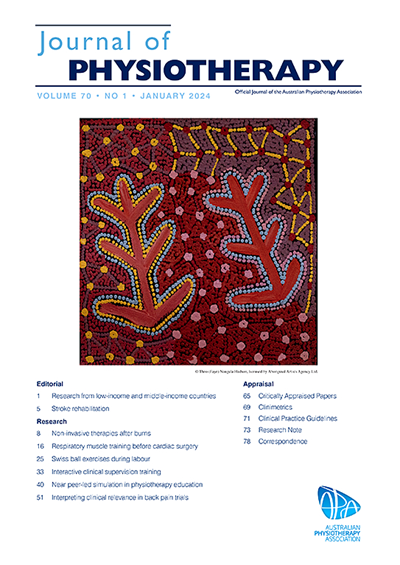Group-based exercise reduces pain and disability and improves other outcomes in older people with chronic non-specific low back pain: the ESCAPE randomised trial
IF 9.7
1区 医学
Q1 ORTHOPEDICS
引用次数: 0
Abstract
Question
In older people with chronic non-specific low back pain (CNSLBP), what is the effect of a group-based exercise protocol compared with a waitlist control on pain intensity, disability, global perceived effect, frequency of falls, fear of falling and physical activity?
Design
Randomised trial with concealed allocation and intention-to-treat analysis.
Participants
One hundred and twenty people aged ≥ 60 years with CNSLBP.
Interventions
Participants were allocated to undertake 1-hour group exercise sessions, three times per week for 8 weeks or to a waitlist control.
Outcome measures
The primary outcomes were pain intensity and disability. Secondary outcomes were the global perceived effect, frequency of falls, fear of falling and physical activity level. Data were collected at baseline, 8 weeks, 5 months and 12 months after randomisation.
Results
Compared with control, group-based exercise reduced pain intensity on a 0-to-10 scale (MD –2.0, 95% CI –2.8 to –1.3) and disability on the 0-to-24 Roland-Morris Disability Questionnaire (MD –3.4, 95% CI –4.7 to –2.1). Group-based exercise also led to higher ratings of global perceived effect sustained through to 12 months and higher levels of physical activity at week 8. The effect on fear of falling was clearly negligible.
Conclusion
Group-based exercise has long-term benefits for pain intensity, disability and global perceived effect, with at least a short-term benefit for physical activity. Group-based exercise can be safely implemented in primary healthcare settings to manage CNSLBP in older people.
Registration
RBR-9j5pqs
问题在患有慢性非特异性腰背痛(CNSLBP)的老年人中,与候补对照组相比,以小组为基础的锻炼方案对疼痛强度、残疾程度、总体感知效果、跌倒频率、跌倒恐惧和体育活动的影响如何?随机试验,采用隐蔽分配和意向治疗分析法:120 名年龄≥ 60 岁的 CNSLBP 患者:干预措施:参与者被分配到每周三次、每次 1 小时的集体锻炼课程中,为期 8 周;或者被分配到候补对照组:主要结果是疼痛强度和残疾程度。次要结果为总体感知效果、跌倒频率、跌倒恐惧和体力活动水平。数据收集时间分别为基线、8周、5个月和随机分配后的12个月:结果:与对照组相比,集体运动降低了0-10级疼痛强度(MD -2.0,95% CI -2.8至-1.3)和0-24级罗兰-莫里斯残疾问卷的残疾程度(MD -3.4,95% CI -4.7至-2.1)。集体锻炼还能使总体感知效果评分提高,并持续到 12 个月,第 8 周的体育锻炼水平也有所提高。对跌倒恐惧的影响显然可以忽略不计:结论:集体运动对疼痛强度、残疾程度和整体感知效果有长期益处,对身体活动至少有短期益处。在初级医疗机构中可以安全地开展集体运动,以控制老年人的中枢神经系统慢性阻塞性脑病:RBR-9j5pqs.
本文章由计算机程序翻译,如有差异,请以英文原文为准。
求助全文
约1分钟内获得全文
求助全文
来源期刊

Journal of Physiotherapy
ORTHOPEDICS-REHABILITATION
CiteScore
11.40
自引率
7.40%
发文量
69
审稿时长
72 days
期刊介绍:
The Journal of Physiotherapy is the official journal of the Australian Physiotherapy Association. It aims to publish high-quality research with a significant impact on global physiotherapy practice. The journal's vision is to lead the field in supporting clinicians to access, understand, and implement research evidence that will enhance person-centred care. In January 2008, the Journal of Physiotherapy became the first physiotherapy journal to adhere to the ICMJE requirement of registering randomized trials with a recognized Trial Registry. The journal prioritizes systematic reviews, clinical trials, economic analyses, experimental studies, qualitative studies, epidemiological studies, and observational studies. In January 2014, it also became the first core physiotherapy/physical therapy journal to provide free access to editorials and peer-reviewed original research. The Australian Physiotherapy Association extended their support for excellence in physiotherapy practice by sponsoring open access publication of all Journal of Physiotherapy content in 2016. As a result, all past, present, and future journal articles are freely accessible, and there are no author fees for publication.
 求助内容:
求助内容: 应助结果提醒方式:
应助结果提醒方式:


